Papers by Shirley N . Dita
2nd DLSU Arts …, 2009
... possibilities of corpus linguistics and the detailed description of the creation and completi... more ... possibilities of corpus linguistics and the detailed description of the creation and completion of the ICE-PHI, as provided by Bautista (2004), have been ... The LOTUS (Large vOcabulary Thai continuous Speech Corpus) Thai corpus has 5,000 vocabularies for speech recognition. ...
Routledge eBooks, Aug 23, 2022

LAP LAMBERT Academic Publishing eBooks, 2007
The present dissertation aims at providing a groundbreaking analysis of the language, illustratin... more The present dissertation aims at providing a groundbreaking analysis of the language, illustrating the intricacies of Ibanag in as clear and comprehensive a manner as possible. As should a reference grammar do, this study deals with the phonology, morphology and syntax of the language. The grammar of the various lexical categories is carefully explicated focusing on their semantic, morphological, and syntactic properties. The present study is basically free from any linguistic theory and uses eclectic approach in describing the features of the language. The corpus used in the study comes from published and unpublished works in Ibanag, transcripts, and from informants who speak the Tuguegarao variety of Ibanag. The description of the language revolves around the following aspects: Phonology (section1), Morphology (section 2), Clause types (section 3), Nominal Marking system (section 4), Pronominals (section 5), Nominals (section 6), Adjectives (section 7), Verbs (section 8), Adverbials (section 9), Numerals (section 10), Existentials (section 11), Connectors (section 12), Interrogativity (section 13), Negation (section 14), and Syntactic Processes (section 15). A glossary of terms and sample Ibanag texts are provided for cross-referencing. It is highly recommended that other aspects of the language be further investigated such as the verbal, adjective, and adverbial systems
Routledge eBooks, Aug 23, 2022
3L; Language, Linguistics and Literature, The …, 2010
This study presents a stylistic analysis of Ophelia Alcantara-Dimalanta"s Montage by providing a ... more This study presents a stylistic analysis of Ophelia Alcantara-Dimalanta"s Montage by providing a syntactic and lexical investigation of the poem. It attempts to investigate the style and the language of the poem by focusing on the overall structure of the poem and the grammatical structure of the sentences thereby leading to a deeper understanding of the text. The analysis focuses on the syntax, specifically the structure of sentences, and the vocabulary of the poem. Some pedagogical implications re then drawn towards the concluding remarks of the study.
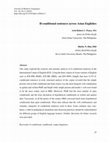
Journal of Modern Languages, 2020
This study explored the syntactic and semantic analysis of if-conditional sentences in the Intern... more This study explored the syntactic and semantic analysis of if-conditional sentences in the International Corpus of English (ICE). Using the three corpora of Asian varieties of English such as ICE-PHI (PhilE), ICE-HK (HKE), and ICE-SING (SingE) that have 6,375 ifconditional sentences in total, structural analysis of the corpus revealed that the simple present verb in both conditional and main clauses was the most frequent verb combination in spoken and written PhilE and SingE while simple present and modal + verb were found to be the most widely used in HKE. Moreover, PhilE had the most number of open conditionals and the least attestation of hypothetical conditionals in written and spoken data. Conversely, in all the genres of the corpus, HKE conveyed much more hypothetical conditionals than open conditionals. These data indicate that the verb combinations and semantic categories of conditional sentences used in these Asian countries may vary; hence, a shift in pedagogical orientation and classroom practices should be contextualized for different groups of English language learners. Further, directions for future research were provided.

Asian Englishes, 2017
ABSTRACT This article investigates split infinitives in 12 World Englishes using Kachru’s concent... more ABSTRACT This article investigates split infinitives in 12 World Englishes using Kachru’s concentric circles framework. Beginning with a brief description of split infinitives, the article explores two significant aspects of splitting: the most common ‘breakers’, and split infinitive use across different genres and domains. Sourcing from the International Corpus of English, findings reveal that split infinitive use in Inner Circle and Outer Circle Englishes both exhibit similarities and differences. The seemingly contradicting data indicate that the split between Inner and Outer Circle Englishes is not as defined as Kachru initially hypothesized, but overlapping. While the similarities can partially be attributed to the prevailing first language (L1) prescriptive norms in the Outer Circle, the perceptible divergences in split infinitive use are mainly argued to involve subconscious substratum transfer and identity-formation processes; the deviations from L1 norms can be viewed as a sign of nativization and, perhaps, differentiation from their ex-colonizers or settlers’ English(es).
aclweb.org
This paper presents the work being done so far on the building of online corpus for Philippine la... more This paper presents the work being done so far on the building of online corpus for Philippine languages. As for the status, the Philippine Languages Online Corpora (PLOC) now boasts a 250,000-word written corpus of the eight major languages in the ...
Asian Englishes, 2015
The Philippines is a nation of 7107 islands located in Southeast Asia. The country is home to an ... more The Philippines is a nation of 7107 islands located in Southeast Asia. The country is home to an estimated 99,809,100 people who thrive in a rich linguistic climate, which hosts 181 living languages (Lewis, Simons, & Fennig, 2014), an English variety (Philippine English) that has reached the fourth phase of Schneider’s dynamic model (Borlongan, 2011), and a rich tradition of applied linguistics (henceforth, AL) research that is aptly captured in Dita’s (2011) Issues and trends in applied linguistics in the Philippines: a decade in retrospect.
This paper presents the work being done so far on the building of online corpus for Philippine la... more This paper presents the work being done so far on the building of online corpus for Philippine languages. As for the status, the Philippine Languages Online Corpora (PLOC) now boasts a 250,000-word written corpus of the eight major languages in the archipelago. Some of the issues confronting the corpus building and future directions for this project are likewise discussed in this paper. 1
This study presents a stylistic analysis of Ophelia Alcantara-Dimalanta‟s Montage by providing a ... more This study presents a stylistic analysis of Ophelia Alcantara-Dimalanta‟s Montage by providing a syntactic and lexical investigation of the poem. It attempts to investigate the style and the language of the poem by focusing on the overall structure of the poem and the grammatical structure of the sentences thereby leading to a deeper understanding of the text. The analysis focuses on the syntax, specifically the structure of sentences, and the vocabulary of the poem. Some pedagogical implications re then drawn towards the concluding remarks of the study.
Ibanag belongs to the Cordilleran subgroup of the Malayo-Polynesian branch of the Austronesian la... more Ibanag belongs to the Cordilleran subgroup of the Malayo-Polynesian branch of the Austronesian language family. This study provides description of the different of the language: phonology, morphology, clause types, the grammar and semantics of nominal markers, pronominals, nominals, adjectives, verbs, adverbs, numerals, existentials, connectors, interrogativity, negation, and syntactic processes. Examples drawn from authentic speakers and published Ibanag texts are provided to illustrate the different features of the language.
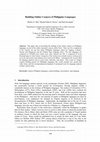
This paper aims at describing the building of the online corpora on Philippine languages as part ... more This paper aims at describing the building of the online corpora on Philippine languages as part of the online repository system called Palito. There are five components of the corpora: the top four major Philippine languages which are Tagalog, Cebuano, Ilocano and Hiligaynon and the Filipino Sign Language (FSL). The four languages are composed of 250,000-word written texts each, whereas the FSL is composed of seven thousand signs in video format. Categories of the written texts include creative writing (such as novels and stories) and religious texts (such as the Bible). Automated tools are provided for language analysis such as word count, collocates, and others. This is part of a bigger corpora building project for Philippine languages that would consider text, speech and video forms, and the corresponding development of automated tools for language analysis of these various forms.

Adverbs have become the ragbag in grammar in which all uncategorized items are relegated. Over th... more Adverbs have become the ragbag in grammar in which all uncategorized items are relegated. Over the years, there have been several studies (e.g., Biber et al., 1999; Halliday, 1994; Hasselgard, 2010; Huddleston & Pullum, 2002; Quirk et al., 1985; Sinclair, 1990) that looked into the syntactic and semantic functions of adverbs. This paper focuses on what Quirk et al. (1985) call ‘disjuncts’ (which refer to the overt expression of an author's or speaker's attitudes, feelings, judgments, or commitment concerning the message. There are various terminologies in literature that have emerged: ‘stance adverbs’, ‘conjunctive adjuncts’, ‘evaluative adjuncts’, ‘sentence adverbs’, to name a few. The common denominator of all these adverbs is that, syntactically, they occupy the most peripheral position in the clause and that, semantically, they distinguish how the propositional content of the clause relates to the context. Using 12 matching corpora of the International Corpus of English ...
In this paper, we introduce the Filipino wordnet project (FilWordNet). Filipino is the national l... more In this paper, we introduce the Filipino wordnet project (FilWordNet). Filipino is the national language of the Philippines spoken by some 90 million people as their first or second language. However, it has historically had a limited number of computational linguistics resources. Creating the Filipino wordnet can be seen as the first step to enable a wide range of research projects. We describe our process of building a wordnet, including issues with the Filipino language itself, its morphology and structure.
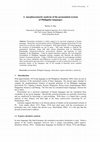
Pronominal orientation is widely argued to be universal component of human languages. Meanwhile, ... more Pronominal orientation is widely argued to be universal component of human languages. Meanwhile, the pronominal system of Philippine languages (henceforth, PL) has always been an obscure subject of investigation. With approximately 150 living languages, the structures of pronominals are just as many. This study attempts to explicate the grammatical functions, along with other known phenomena such as cliticization, homography, inclusivity/exclusivity, person-deixis interface, and hierarchy of some languages in the Philippines. Using an ergative-absolutive analysis, this cross-linguistic investigation of Philippine languages presents examples that illustrate the distinctive features of personal pronouns. Using a 100,000-word corpus for each language included, there are various similarities and differences revealed by the study: (1) some languages allow encliticization and some don't; (2) homography, as well as inclusivity/exclusivity, is a persistent feature of the languages; and (3) the strength of hierarchy poses semantic constraints, among others.
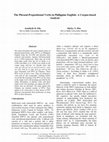
The study determines the most common forms of phrasal-prepositional verbs (PPVs) in Philippine En... more The study determines the most common forms of phrasal-prepositional verbs (PPVs) in Philippine English using the ICE-PHI and describes their syntactic and semantic features, following Quirk et al.’s (1985) framework. Thirty nine out of the forty-eight words from the list of Quirk et al. (1985) and Biber et al. (1999) were found in the corpus using AntConc 3.4. Results show that come up with, get out of, look forward to, come out with, hold on to, and catch up with are the most frequently used PPVs by Filipinos. These PPVs occur in active voice. They are intransitive verbs and are also inseparable. Findings further reveal that the meanings of the PPVs are the same as the single-word verb meanings provided by the online dictionaries of phrasal verbs, and those single-word verb meanings can replace the PPVs. Hence, they are idiomatic. The study implies that Filipinos use minimal number of PPVs. They appear to be conservative in their choice of PPV structure, but generally show proficie...








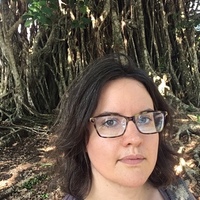


Uploads
Papers by Shirley N . Dita
(Philippine English) that has reached the fourth phase of Schneider’s dynamic model (Borlongan, 2011), and a rich tradition of applied linguistics (henceforth, AL) research
that is aptly captured in Dita’s (2011) Issues and trends in applied linguistics in the Philippines: a decade in retrospect.